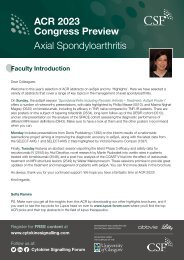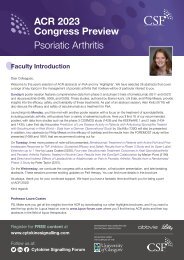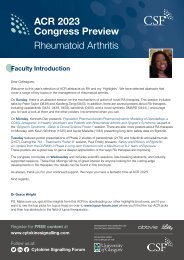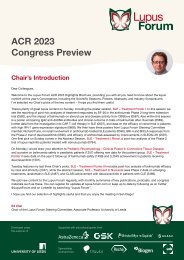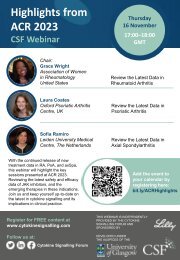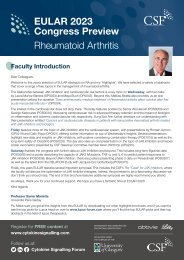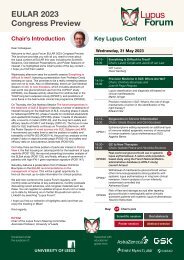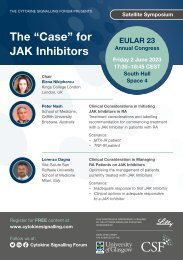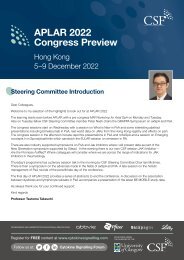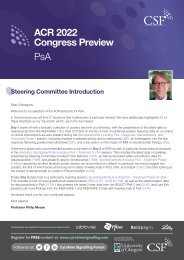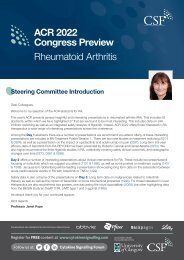EULAR 2018 Review
Create successful ePaper yourself
Turn your PDF publications into a flip-book with our unique Google optimized e-Paper software.
Poster sessions I, II and III<br />
Upadacitinib efficacy and safety in RA<br />
FitzGerald, et al presented findings from the Phase 3 SELECT-NEXT (n=661) and<br />
SELECT-BEYOND (n=498) trials on the speed of response to upadacitinib across disease<br />
measures. In these cohorts of patients with RA and an inadequate response to csDMARDs<br />
or bDMARDs, those receiving upadacitinib at either 15 mg or 30 mg QD were more likely<br />
to achieve clinical responses at significantly earlier timepoints compared with patients<br />
receiving placebo. The median times to achieve ACR20 were 4 weeks with upadacitinib 15<br />
mg QD, 2–3 weeks with upadacitinib 30 mg QD, and 12 weeks with placebo. The median<br />
time to low disease activity (LDA) by CDAI and SDAI was approximately 12 weeks across<br />
upadacitinib doses and populations; patients receiving placebo did not achieve this<br />
measure within that time. The time taken to achieve various clinical responses was<br />
consistent irrespective of having an inadequate response to csDMARD or bDMARD<br />
[#0239].<br />
Vollenhoven, et al. examined upadacitinib efficacy at 12 weeks of treatment (as per T2T<br />
recommendations) in the SELECT-NEXT and SELECT-BEYOND trials. In both<br />
populations of patients with RA, significantly more patients on upadacitinib versus placebo<br />
achieved an ACR50 response. Among ACR50 responders at 12 weeks, approximately<br />
one-half of csDMARD-IR patients and one-third of the bDMARD-IR patients achieved an<br />
improvement in all 7 ACR components [#0244].<br />
Genovese, et al. presented the long-term safety and efficacy profile for upadacitinib from<br />
an ongoing open-label, long-term extension (OLE) of two Phase 2 studies (BALANCE-<br />
EXTEND). This included 493 patients with RA, with a total of 725 patient-years of<br />
cumulative exposure. The event rate per 100 patient years (E/100PY) was 170.5 for any<br />
AE in the OLE, 9.4 for SAEs, 2.3 for serious infection, 3.7 for HZ, 0.8 for malignancies<br />
excluding NMSC, and 0.7 for adjudicated cardiovascular events. There were 2 deaths (1<br />
sudden death adjudicated as unknown cause, and 1 due to Hodgkin’s lymphoma). Efficacy<br />
was maintained in patients receiving 6 mg upadacitinib BID from Day 1 of the OLE who<br />
completed Week 72 (55% of patients met ACR70, and 80% were in LDA by DAS28-CRP<br />
and CDAI) [#0236].<br />
The results of a Phase 3/4, randomised, placebo-controlled, double-blind study of<br />
upadacitinib in Japanese patients with active RA and an inadequate response to<br />
csDMARDs were presented in a poster by Tanaka, et al. A total of 197 patients received<br />
treatment and 187 completed the double-blind period. ACR20 rates at 12 weeks in patients<br />
receiving upadacitinib 7.5, 15, and 30 mg or placebo were 75.5%, 83.7%, 80% and 42.9%,<br />
respectively. ACR50 and ACR70 responses were achieved by significantly higher<br />
proportions of patients receiving upadacitinib versus placebo; more patients receiving<br />
upadacitinib 15 mg and 30 mg achieved these responses compared with those receiving<br />
upadacitinib 7.5 mg. The overall safety and tolerability profile was consistent with that<br />
observed in Phase 2 and 3 studies to date. Rates of any AEs, SAEs and infections were<br />
numerically higher in patients receiving upadacitinib 30 mg compared with the lower<br />
upadacitinib doses and placebo groups; CPK elevations and lymphopenia occurred more<br />
frequently with upadacitinib 30 mg [#0257].



